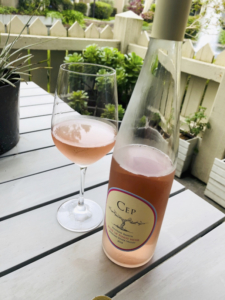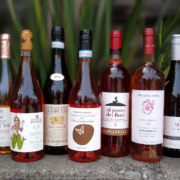 With the arrival of spring, Paul Marcus Wines is ready to showcase our growing rosé selection!
With the arrival of spring, Paul Marcus Wines is ready to showcase our growing rosé selection!
What does a light pink wine signify? Will a darker hued rose taste sweet? Making a fruity but balanced pink wine is no small task. In fact, many winemakers confide that vinifying rosé wine can be more challenging than red or white wine production.
Why is this so? The answer: A rosé wine must walk a tightrope, balancing components of fruit, acid and alcohol with very little margin of error. Too much of any one component leaves what should otherwise be a fresh, crisp and vibrant pink, flat on its back, tasting ponderous and dull. However, making the perfect pink wine is not just a matter of mixing red and white grape juice…
How is Rosé Wine Made?
High quality rosé wine is made utilizing the following 3 production methods:

Direct Press Method
After harvest, red grapes undergo skin contact for a short period of time before being pressed off. How much time exactly? Anywhere from almost immediately to 16 hours or so. During this period, a limited amount of color is extracted from the skins, often resulting in a lightly colored juice. A very pale and barely pink wine is sometimes referred to as a Vin Gris. If the grapes are left on their skins a bit longer, a darker hue will result. A rosé produced via the direct press method is pictured above.

Saignée Method
The process saignée or bleeding off juice, was originally employed as a method of concentrating wine must before fermentation in order to produce a more robust red. Red grapes, either crushed or uncrushed but broken (preferable), are chilled down and macerate, generally between 1-4 days. The juice is then be drawn off or “bled” and without being pressed. This juice is then often fermented at cooler temperatures, in a similar manner to that of a white wine the finished rosé is generally a more robust and deeply colored wine. A rosé produced via the saignée method is pictured above.
Note: the finished color of a rose does not indicate a sweetness level. If all the sugar has been converted to alcohol during the fermentation process, the resulting wine will be a dry one, regardless of the color.
Blended Method
 After fermentation is complete, white and red wines (usually around 5%) are blended together in order to achieve a desired level of pink or blush tint. The blending method is rarely employed in making still rosé wines and is illegal in the EU. However, the blended method is commonly used in the production of high-quality rosé Champagne as well as high quality sparkling wines around the world. The Champagne house Billecart-Salmon produces their iconic rosé Champagne in this manner.
After fermentation is complete, white and red wines (usually around 5%) are blended together in order to achieve a desired level of pink or blush tint. The blending method is rarely employed in making still rosé wines and is illegal in the EU. However, the blended method is commonly used in the production of high-quality rosé Champagne as well as high quality sparkling wines around the world. The Champagne house Billecart-Salmon produces their iconic rosé Champagne in this manner.
With so many rosé wines, and so little time, it’s time to dive in and get started!
These 2018 rosé wines from our local winery friends are now available at Paul Marcus wines and ready for you to take home.

Expect to see a steady parade of pink over the next several months, from wine regions across the globe, and produced via the 3 methods of rose production described above. As you may know, we’re huge Rosé fanatics, and we can’t stop talking about Pink!
We’ll see you at the shop!





Leave a Reply
Want to join the discussion?Feel free to contribute!